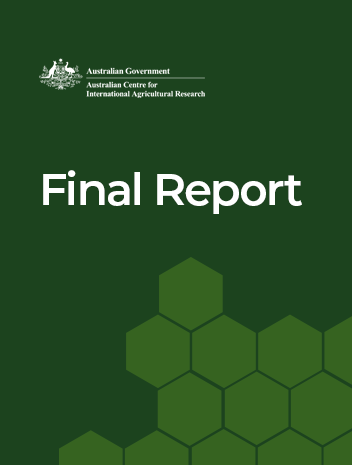- HomeHome
-
About ACIAR
- Our work
- Our people
-
Corporate information
- ACIAR Audit Committee
- Commission for International Agricultural Research
- Policy Advisory Council
- Agency reviews
- Executive remuneration disclosure
- Freedom of information (FOI)
- Gifts and benefits register
- Information publication scheme
- List of new agency files
- Contracts
- Legal services expenditure
- Privacy impact assessment register
- Commonwealth Child Safe Framework
- Benefits to Australia
- Careers
- 40 years of ACIAR
-
What we do
- Programs
- Cross-cutting areas
- Resources
- Where we work
-
Funding
- Research projects
- Fellowships
-
Scholarships
- John Allwright FellowshipScholarships to study in Australia for ACIAR partner country scientists to have Australian postgraduate qualifications
- ACIAR Pacific Agriculture Scholarships and Support and Climate Resilience Program
- Alumni Research Support Facility
- Publications
- News and Outreach
Project final report
Validating technologies for assessing and monitoring the impacts of re-wetting of peatland Indonesia using eddy flux towers coupled with the Chameleon sensors - Final Report
Date released
22 May 2024
ISBN
978-1-923261-01-3
Publication Code
FR2021-016
Overview
This project aimed to empower communities and government to remotely and accurately monitor and evaluate peatland restoration by integrating environmental data on peatland water and carbon fluxes with local decision-making structures.
The project had three interconnected objectives: (1) to monitor environmental fluxes using eddy covariance (EC) flux tower and Chameleon soil water sensors; (2) to engage local stakeholders through participatory action research and workshops; and (3) to co-create user-oriented decision support tools to empower communities and government to monitor peatland condition remotely.
The project found that evapotranspiration and CO2 fluxes did not vary strongly between months or the wet and dry seasons. The peatland was a very small net carbon source throughout the measurement period. The project also found that the Chameleon soil water system was a useful and engaging tool for community stakeholders, as it resonated with their local and traditional knowledge and lived experience of peatland condition.
Other results and impacts
- Quantified water and carbon fluxes in a regenerating degraded tropical peatland for the first time, and by testing and validating novel technologies for environmental monitoring of peatland hydrological condition.
- Enhanced the skills and knowledge of the Indonesian and Australian teams in operating and maintaining the flux tower and Chameleon equipment and by conducting social research with community and government stakeholders.
- Generated community impacts by involving the local community in peatland monitoring and decision-making, providing alternative livelihood opportunities, and empowering them to protect their peatland.
- Contributed to the scientific basis for future carbon market activity in the Mawas peatland, and provided baseline data to inform peatland conservation and restoration initiatives.



